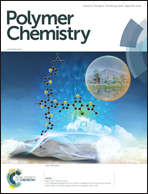The synthesis of a contraction-type glucose-sensitive microgel working at physiological temperature guided by a new glucose-sensing mechanism†
Abstract
Contraction-type glucose-sensitive microgels, which shrink upon the addition of glucose, have potential for applications in self-regulated insulin release and glucose sensing. Poly(N-isopropylacrylamide-co-2-acrylamidophenylboronic acid) (P(NIPAM-2-AAPBA)) microgel shrinks monotonously with increasing glucose concentrations, but does not work at physiological temperature. Here we re-examined its glucose-sensing mechanism and found that the crosslinking mechanism, which is commonly used to explain the behaviors of other contraction-type gels, cannot explain the behavior of the P(NIPAM-2-AAPBA) microgel. To explain the behavior of the P(NIPAM-2-AAPBA) microgel, a new glucose-sensing mechanism was proposed. Unlike other PBA-functionalized gels, in which glucose changes their swelling degree via changing the ionization degree or crosslink degree, in the case of the P(NIPAM-2-AAPBA) microgel, glucose changes the gel swelling degree via lowering the VPTT (volume phase transition temperature) of the microgel as an additive. The addition of glucose is equivalent to raising the temperature of the microgel dispersion, and therefore leads to shrinkage of the microgel. Binding of glucose with PBA groups shortens the distance between glucose and PNIPAM chains, and hence significantly enhances the ability of glucose to lower the VPTT of the microgel. This new mechanism can explain well the monotonous shrinking of the microgel with increasing glucose concentration, the response of the microgel to other saccharides besides glucose, and the existence of an optimal temperature for the microgel to respond to glucose. The new mechanism also suggests that the optimal temperature for glucose sensing can be modulated by tuning the VPTT of the microgel. Guided by the new mechanism, a new contraction-type glucose-sensitive microgel working at physiological temperature was successfully synthesized.



 Please wait while we load your content...
Please wait while we load your content...